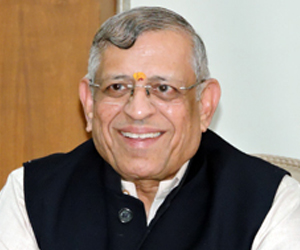"The most effective way to destroy people is to deny and obliterate their own understanding of their history,” said George Orwell. The latest Indian example of how Orwell’s dictum works is the obliteration of the Sengol ceremony from the history of India’s freedom at midnight and the denial that it ever happened, after the truth that it did happen after all came out. The 75-year-old history of the Sengol was revealed four years back spontaneously, accidentally, and by no design. Who revealed it? Tamil media. Surprising? Read on.
Tamil media’s revelation
It does not need a seer to say why the Tamil media got excited when it got the lead about the Sengol history. The Sengol was the Chola empire’s sacred symbol for ‘Aram’ – the Tamil equivalent for dharma. That Chola’s Sengol symbolised India’s Independence was itself a news of high value and a matter of pride for the Tamil audience. It was enough for the Tamil media to probe deep into the Sengol history.
Different Tamil magazines reported from around 2019 that Mountbatten asked Nehru what was the Indian symbolism for the transfer of power from the British to India. Confused, Nehru looked to Rajaji, the elder statesman with traditional knowledge. Rajaji suggested the Chola model of vesting Sengol in the new ruler be adopted for the August 14-15 midnight ceremony. With Nehru okaying, Rajaji arranged for the Tiruvavaduthurai Adheenam to come over to Delhi to perform the Sengol ceremony.
Tamil magazines described the transfer of power ceremony graphically. They reported that the Adheenam saint gave the Sengol to Mountbatten, got it back, gave Gangajal abhishekam to it, recited the Thevaram verses invoking the blessings of Lord Shiva for Independent India’s rule to last forever and vested the Sengol in Nehru’s hands. Photos of Pundit Nehru holding the Sengol with reverence after receiving it from the Adheenam were also published. The magazines also traced and found the Sengol physically in Allahabad Museum. Tamil media reports were brought to the Modi government’s notice by Dr Padma Subrahmaniam, the famous scholar and artiste.
If the Tamil media had not dug out the Sengol history and subsequently if those reports had not been brought to the government’s notice, its history would have been buried forever. The Modi government on a mission mode to trace and discover the forgotten heroes and pieces of history under its Azadi Ka Amrut Mahotsav project, began probing the Sengol issue. It ended up unearthing testimonies that proved the Tamil media reports were beyond doubt.
Sengol – “Officially announced”, “to be taken to Constituent Assembly house”
The Sengol ceremony was no secret or personal religious ritual of Nehru. It was an officially announced function that made it to national news long before the August 14-15 midnight. Here is a sample of the media reports on the Sengol in the second week of August 1947. “In connection with Independence Day, Tiruvavaduthurai Adheenam has arranged to perform special puja to Shiva and to confer the lord’s blessings on Pandit Jawaharlal Nehru. The puja prasadams and a Sceptre made of gold will be presented to Pandit Nehru at his residence in New Delhi at 11 p.m. on August 14.” This was The Hindu – three days ahead of the ceremony [Aug 11, 1947].
A day before the ceremony The Indian Express [Aug 13, 1947] reported that the Sceptre ceremony was “officially announced” adding that the Adheenam would present and Nehru would accept. Saying that Nehru had accepted to receive the Sengol exactly at 11.5 [?] pm, it reported that the Sengol would be “taken to the Constituent Assembly Hall in procession”. “The Sceptre ceremony will be preceded by a procession from the South India Boarding House, Connaught Circus,” reported Hindustan Times on the same date [13th].
The reports that the ceremony was “officially announced”, and that the Sengol would be taken in procession to Constituent Assembly Hall — which became Parliament later — made it clear that the Sengol vesting was part of the August 14-15 government protocol. Did the Tamil Adheenam go in a procession for the Sengol ceremony under government protocol to present a memento or as a personal gift, as some intellectuals are trying to morph the Sengol? Now come to the testimonies that the “intellectuals” are sidestepping. Globally reputed authors saw in the Sengol ceremony an Indian civilisational expression.
Symbol of assumption of power, say reputed authors
Time magazine [27.8.1947], D F Karaka, the famous journalist and editor of the Current magazine, in his book Betrayal of India, Dominique Lapierre and Larry Collins in their famous book, Freedom at Midnight – all described the Sengol ceremony as symbolising the traditional Indian way of a new ruler assuming power. “On the eve of Independence, even the agnostic Nehru fell into religious spirit,” said the Time. Karaka wrote, “The mood of New Delhi had become almost superstitious.”
“From Tanjore came Hindu ascetics who thought that Nehru as the first head of the Indian state ought, like the ancient Indian kings, to receive the symbol of power and authority,” wrote the Time. “It was traditional in ancient India to derive power and authority from the holy men. Pandit Nehru yielded to all this religious ceremony because it was said of the kings of India that this was the traditional way of assuming power,” wrote Karaka. “As once Hindu holy men had conferred upon ancient India’s kings their symbols of power, so the sannyasin had come to bestow their antique emblems of authority on the man about to assume the leadership of a modern Indian nation,” wrote Dominique Lapierre and Larry Collins.
Time magazine said, on the evening of August 14, the Adheenam team went in a slow procession in an ancient Ford car to Nehru’s home; an escort bore a large silver platter on which there was peethambaram; they carried a golden spectre wrapped in a peethambaram, opened and took the spectre, spilled holy water on it, and smeared Nehru’s forehead with holy ash.
The Hindu priests, who according to Karaka, arrived post haste from Tanjore for the ritual, chanted hymns and sprinkled holy water over them; the Adheenam wrapped Nehru with peethambaram and handed over the spectre to Nehru. The Adheenam team and prasadams from Nataraja Temple were flown by plane to Delhi. Blind to these testimonies, the “intellectuals” keep contending that the Sengol was just a memento. No need to waste further time on them.
Symbolised transfer of power, say six independent testimonies
“That Sengol symbolised the transfer of power is a bogus story spun by the BJP’s faking factory” — repeatedly howled Congress spokesman Jairam Ramesh. He had no evidence other than the claims of the intellectuals who were themselves blind to facts. It became like the proverbial blind leading the blind. Jairam said that in the absence of any proof that the Sengol was first presented to Mountbatten and taken back and vested in Nehru after rituals, the story that the Sengol symbolised the transfer of power was bogus. Overworked perhaps, he did not fully read the 35-page long government docket on the August 14-15 Sengol ceremony nor look at the government’s website on Sengol.
The government had cited five independent testimonies which, while corroborating one another, said explicitly that the Sengol indeed “symbolised the transfer of power”. One, the Adheenams’ recorded institutional memory; two, the institutional memory of the Vummidi Jewelers recorded on their website; three, personal testimony of the 96-year-old Vummidi Bangaru Chetty who made the Sengol; four, the Policy Report of 2021-22 Hindu Religious and Charitable Endowment Department submitted to the Tamil Nadu Assembly by the DMK government that came to power in May 2021; and five, the totally independent recollection of the universally revered Kanchi Mahaswami decades before in 1978.
All of them, including the Tamil Nadu government’s report, independently testified that the Sengol was the symbol of the transfer of power to which Mountbatten and Nehru were parties. All except the Tamil Nadu government’s brief policy report corroborated the Tamil media description of the details of the Sengol ceremony, including Gangajal abhishekam to the Sengol and mentioned Rajaji as the intermediator between Nehru and the Adheenam. After Prime Minister Narendra Modi installed the Sengol in Parliament on May 28, Masilamani (96 years), the secretary of the Adheenam who had arranged the Sengol vesting, and two of his successors, gave an interview to a news channel. He recollected even the minutest details of the chain of events associated with the ceremony, including that the then governor of Madras and the collector of Tanjore were also involved in organising the ceremony. His was the sixth testimony.
Obliterate, now deny
How did the evidence of Sengol ceremony which existed outside was not found inside the government? The answer is obvious. After adopting the Sengol as symbolic of the transfer of power, at some point, those in power must have felt that the August 14-15 history would be an inconvenient truth, inconsistent with the new idea of India they began expounding post Independence. Result, all in-house evidence of the Sengol ceremony history, including the photos taken at that time – which the Adheenam must have got only from the government – was obliterated.
The Sengol itself was first turned into a “brass stick” and recorded as a “memento” at the Nehru Gallery in the Allahabad Museum. Later, in the glass case in which the 5-ft long Sengol was exhibited, it was marked as a “Walking Stick presented to Pundit Nehru” completing its obliteration from history. With tons of proof emerging and establishing the Sengol as the symbol of the transfer of power in 1947, the very ideological players who must explain its records and history, are the ones now asking for proof of the Sengol ceremony.
Is this not, as Orwell would say, obliterating the Sengol history and the Sengol itself, to destroy the pre-Independence identity of India, deny it ever happened, and even ask for evidence that it had done away with?
If the vesting of the Sengol in 1947 symbolised the transfer of power, what does its installation in Parliament 75 years signify? Read tomorrow, Sengol: Recalling the pre-March 24, 1940 India.











Post new comment